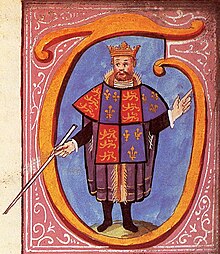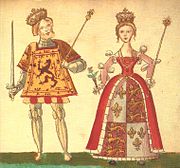Tabard
This article needs additional citations for verification. (June 2012) |
A tabard is a type of short coat that was commonly worn by men during the
In modern
Middle Ages
A tabard (from the French tabarde) was originally a humble outer garment of tunic form, generally without sleeves, worn by peasants, monks and foot-soldiers. In this sense, the earliest citation recorded in the Oxford English Dictionary dates from c. 1300.[1]
By the second half of the 15th century, tabards, now open at the sides and so usually belted, were also being worn by knights in military contexts over their armour, and were usually emblazoned with their arms (though sometimes worn plain). The Oxford English Dictionary first records this use of the word in English in 1450.[1] Tabards were apparently distinguished from surcoats by being open-sided, and by being shorter.[citation needed] In its later form, a tabard normally comprised four textile panels – two large panels hanging down the wearer's front and back, and two smaller panels hanging over his arms as shoulder-pieces or open "sleeves" – each emblazoned with the same coat of arms. Tabards became an important means of battlefield identification with the development of plate armour as the use of shields declined. They are frequently represented on tomb effigies and monumental brasses of the late 15th and early 16th centuries.
A very expensive, but plain, garment described as a tabard is worn by
At
A surviving garment similar to the medieval tabard is the monastic scapular. This is a wide strip of fabric worn front back of the body, with an opening for the head and no sleeves. It may have a hood, and may be worn under or over a belt.
British heraldry

By the end of the 16th century, the tabard was particularly associated with officers of arms. The shift in emphasis was reported by John Stow in 1598, when he described a tabard as:
a Jacquit, or sleevelesse coat, whole before, open on both sides, with a square collor, winged at the shoulders: a stately garment of olde time, commonly worne of Noble men and others, both at home and abroade in the Warres, but then (to witte in the warres) theyr Armes embrodered, or otherwise depicte uppon them, that every man by his Coate of Armes might bee knowne from others: but now these Tabardes are onely worne by the Heraults, and bee called their coates of Armes in service.[4]
In the case of Royal officers of arms, the tabard is emblazoned with the coat of arms of the sovereign.
It was at one time the custom for English pursuivants to wear their tabards "athwart", that is to say with the smaller ("shoulder") panels at the front and back, and the larger panels over the arms; but this practice was ended during the reign of James II and VII.[5][7]
The derisive Scots nickname of "Toom Tabard" for John Balliol (c. 1249 – 1314) may originate from either an alleged incident where his arms were stripped from his tabard in public,[8] or a reference to the Balliol arms which are a plain shield with an orle, also known as an inescutcheon voided.[9]
Canadian heraldry
In the
Gallery
-
Gelre Herald to theDuke of Guelders, c. 1380
-
James I, King of Scotland 1406–1437, and his wife Joan Beaufort
-
Tabards displayingquartered coats of arms on front and sleeves: the Denys brass of 1505, Olveston, Gloucestershire
-
Heraldic tabards worn at the funeral of Albert VII, Archduke of Austria, in Brussels in 1622
-
A pursuivant wearing his tabard "athwart". A drawing by Peter Lely from the 1660s.
-
Peter O'Donoghue, Bluemantle Pursuivant, photographed in 2006
-
A modern protective tabard worn by a bakery worker
-
Orange high-visibility tabards worn by competitive motorcyclists
Cultural allusions
A tabard was the inn sign of the Tabard Inn in Southwark, London, established in 1307 and remembered as the starting point for Geoffrey Chaucer's pilgrims on their journey to Canterbury in The Canterbury Tales, dating from about the 1380s.
In
See also
References
- ^ a b "tabard". Oxford English Dictionary (Online ed.). Oxford University Press. (Subscription or participating institution membership required.)
- ISBN 185709171X.
- ^ Farmer, John Stephen (1903). Slang and Its Analogues Past and Present: A Dictionary, Historical and Comparative, of the Heterodox Speech of All Classes of Society for More Than Three Hundred Years : with Synonyms in English, French, German, Italian, Etc. Unknown. p. 54.
- ^ Stow, John (1598). A Survay of London. London. p. 338.
- ^ a b Eirìkr Mjoksiglandi Sigurdharson (December 31, 2003). "A Review of the Historical Regalia of Officers of Arms". heraldry.sca.org. Retrieved 8 June 2012.
- ^ Marks, Richard; Payne, Ann, eds. (1978). British Heraldry: from its origins to c.1800. London: British Museum. p. 51, plate.
- ISBN 9780171441024.
- ISBN 9780750951432. Retrieved 2 December 2018.
- ^ Hodgson, John; Hodgson-Hinde, John (1832). A History of Northumberland, in three parts. Printed by E. Walker. p. 124. Retrieved 2 December 2018.
- ^ Bentley, E. C. (1953) [1938]. "The genuine tabard". Trent Intervenes. London: Penguin. pp. 7–24.









